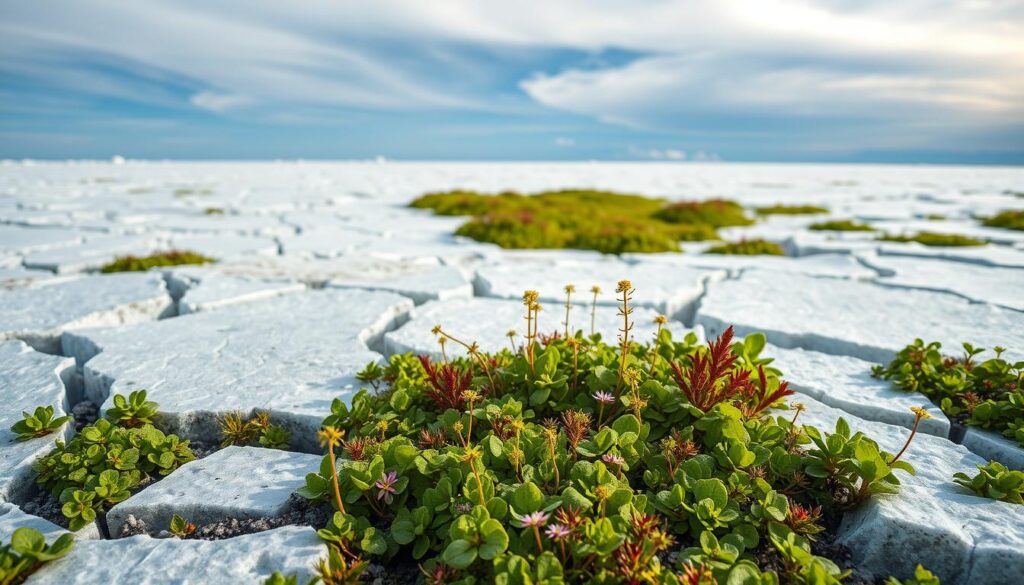A groundbreaking study has revealed that climate change is triggering an unexpected surge in plant growth worldwide. By analyzing ice cores from Antarctica, scientists have discovered a significant increase in global plant activity over the past few decades.
This phenomenon is closely linked to the impact of global warming, which is altering ecosystems and promoting the growth of vegetation in various parts of the world. As the planet continues to warm, understanding these changes is crucial for predicting future environmental shifts.
Key Takeaways
- The analysis of Antarctic ice cores has shown a significant increase in global plant growth.
- Climate change is a key driver of this surge in plant activity.
- Global warming is altering ecosystems and promoting vegetation growth.
- Understanding these changes is crucial for predicting future environmental shifts.
- The study’s findings have important implications for climate modeling and environmental policy.
The Science Behind Antarctic Ice Core Analysis
The detailed study of Antarctic ice cores is revolutionizing our understanding of climate science and its impacts on global vegetation. Antarctic ice core analysis has become a vital tool for scientists to understand Earth’s climate history.
How Ice Preserves Earth’s Atmospheric History
Antarctic ice cores contain layers of ice that have built up over thousands of years, trapping air bubbles and chemical signatures that provide a record of the Earth’s atmospheric history. This natural archive allows scientists to study the composition of the atmosphere in the past, including levels of greenhouse gases and other pollutants.
Trapped Air Bubbles and Chemical Signatures
The air bubbles trapped in the ice cores contain samples of the atmosphere from the past, providing direct evidence of changes in greenhouse gas concentrations over time. Chemical signatures, such as levels of certain isotopes, offer additional information about past climate conditions.
Timeline of Climate Records in Ice
The layers of ice in Antarctic cores can be dated to create a timeline of climate records, stretching back hundreds of thousands of years. This timeline is crucial for understanding the natural variability of the climate and the impact of human activities.
Methods Used to Extract Plant Growth Data
To extract data on plant growth from ice cores, scientists use various analytical techniques. One key method is carbon isotope analysis, which helps to reconstruct past vegetation patterns.
Carbon Isotope Analysis Techniques
Carbon isotope analysis involves measuring the ratio of different carbon isotopes in the ice core samples. This ratio can indicate the types of vegetation that were present in the past and how they responded to changes in climate.
Connecting Ice Data to Vegetation Patterns
By combining the data from ice cores with other climate records, scientists can connect the past climate conditions to vegetation patterns. This information is essential for understanding how plant growth has accelerated in recent times.
Antarctic Ice Reveals Earth’s Accelerating Plant Growth
Antarctic ice cores hold the key to understanding the rapid changes in plant growth patterns across the globe. By analyzing these ice cores, scientists can gain insights into historical plant growth patterns, recent accelerations, and regional variations in vegetation changes.
Historical Plant Growth Patterns Uncovered
The ice cores extracted from Antarctica contain layers of ice that have built up over centuries, trapping air bubbles that hold the secret to past atmospheric conditions. These natural archives allow researchers to reconstruct the history of plant growth and understand how it has evolved over time.
Pre-Industrial Revolution Baselines
These ice cores provide a baseline of plant growth before the Industrial Revolution, giving scientists a reference point to compare past and present plant growth. This baseline is crucial for understanding the impact of industrial activities on the environment.
Gradual Changes Through Centuries
Analysis shows gradual changes in plant growth over the centuries, influenced by natural climate variability. These gradual changes provide context for understanding more recent and rapid changes in plant growth.
Recent Acceleration: Causes and Measurements
In recent years, there has been a noticeable acceleration in plant growth, attributed to various factors. Scientists have been studying these changes to understand their causes and implications.
Rising Carbon Dioxide Levels
Rising CO2 levels have been identified as a significant factor, as CO2 is a crucial component for photosynthesis. Increased CO2 can enhance plant growth by providing more resources for plants to undergo photosynthesis.
Temperature and Precipitation Changes
Changes in temperature and precipitation patterns also play a critical role in the acceleration of plant growth. Warmer temperatures and altered precipitation patterns can create more favorable conditions for plant growth in certain regions.
Regional Variations in Vegetation Changes
Regional variations in vegetation changes are observed, with differences noted between the Northern and Southern Hemispheres. Understanding these regional variations is essential for grasping the full impact of climate change on global vegetation.
Northern vs. Southern Hemisphere Differences
The Northern Hemisphere, with its larger landmass, shows different patterns of plant growth compared to the Southern Hemisphere. These differences are influenced by varying land use practices, climate conditions, and other factors.
Ecosystem-Specific Responses
Different ecosystems respond uniquely to the changing climate, with some showing more pronounced changes in plant growth. For instance, some ecosystems may experience enhanced growth due to increased CO2, while others may suffer due to changing precipitation patterns.
| Hemisphere | Plant Growth Change | Primary Cause |
|---|---|---|
| Northern | Significant Increase | Rising CO2 Levels |
| Southern | Moderate Increase | Temperature Changes |
Environmental and Societal Implications
As we analyze the Antarctic ice cores, we uncover the complex relationships between climate change and environmental systems. The data reveals significant implications for our understanding of global ecological changes.
Carbon Cycle Disruptions
The analysis of Antarctic ice cores shows that the carbon cycle is being disrupted due to increasing levels of greenhouse gases. This disruption affects the balance between carbon sinks and sources.
Changing Carbon Sinks and Sources
The ice core data indicates that some regions are becoming more significant carbon sinks, while others are turning into carbon sources. This shift has profound implications for global climate regulation.
Ocean-Atmosphere-Land Interactions
The interactions between the ocean, atmosphere, and land are critical in understanding the carbon cycle disruptions. The ice core data provides insights into these complex interactions.
Agricultural and Ecological Consequences
The impact of greenhouse gases on vegetation is a critical area of study. Changes in plant growth patterns and productivity have significant implications for agriculture and ecosystems.
Crop Productivity Shifts
As climate change continues, some regions may experience increased crop productivity, while others may face declines. Understanding these shifts is crucial for agricultural planning.
Biodiversity and Ecosystem Services
The changes in vegetation patterns also affect biodiversity and ecosystem services. The loss of certain plant species can have cascading effects on entire ecosystems.
| Region | Projected Change in Plant Growth | Impact on Ecosystem Services |
|---|---|---|
| Amazon Rainforest | Increase | Enhanced biodiversity |
| African Savanna | Decrease | Reduced ecosystem resilience |
| North American Forests | Variable | Mixed impacts on forest ecosystems |
Future Projections Based on Ice Data
The scientific study of Antarctic ice provides valuable data for modeling future plant growth trends. Understanding these trends is essential for predicting potential tipping points in climate change.
Modeling Plant Growth Trends
By analyzing the ice core data, researchers can model future changes in plant growth. These models help in predicting regional variations in vegetation changes.
Potential Tipping Points
The ice core data also helps in identifying potential tipping points in the Earth’s climate system. Understanding these tipping points is crucial for mitigating the worst effects of climate change.
Conclusion
The analysis of Antarctic ice reveals a significant increase in plant growth worldwide, driven by the global warming impact on green vegetation patterns. As the planet continues to warm, the rate of plant growth is accelerating, with far-reaching implications for the environment and ecosystems.
This phenomenon is closely linked to changes in the carbon cycle, affecting not only the atmosphere but also agricultural productivity and ecological balance. Understanding these changes is crucial for predicting future environmental shifts and developing strategies to mitigate their effects.
As research continues to uncover the complexities of global vegetation patterns, it becomes increasingly clear that the global warming impact is a driving force behind the accelerating plant growth observed across the globe. By studying Antarctic ice cores, scientists can gain valuable insights into the Earth’s history and better prepare for the challenges ahead.



